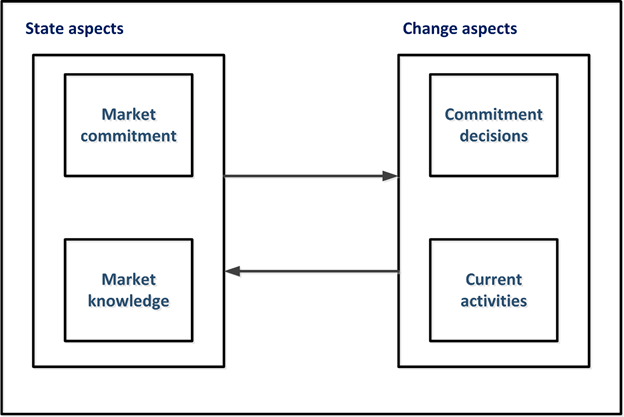Internationalization Theory
Acronym
NA
Alternate name(s)
NA
Main dependent construct(s)/factor(s)
Foreign market knowledge
Main independent construct(s)/factor(s)
Foreign market Commitment, export activities, extent of overseas collaborations
Concise description of theory
The Internationalization theory of the MNC is concerned with entry mode choices in single markets based on transaction cost analysis. In this theory lacking foreign market knowledge is a central construct. Lacking foreign market knowledge increases risk exposure to the internationally expanding firms, to which it responds through either limited resource commitment (stage models of internationalization) or high control modes (internalization theory).
Internationalization theory have an important implication of lacking foreign market knowledge, which suggests that foreign market penetration in a single market follows a path of increasing commitment from no regular export activities through export by agents and licensing agreements to the more commitment intensive establishment of sales subsidiaries, joint ventures and overseas production units. As experimental knowledge about particular markets accumulates, internationalization theory suggests that risk exposure is attenuated and firms do escalate their resource commitments from low to high investment intensive foreign entry modes. In other words, if there is lacking knowledge about foreign markets, firms limit their risk exposure through limiting resource commitment
Three most popular internationalization theories are Uppsala model, Network approach and international New Ventures or also known as Born Global.
1. Uppsala Model
The Uppsala model is a theory that explains how firms gradually intensify their activities in foreign markets, and it is being introduced by Jan-Johansson and Jan-Erik Ahlen in 1977. Their model emphasized the gradual and incremental character of international expansion. Organizations could best reduce their risk level by adopting this approach
2. The Network Approach
Johanson and Mattsson (1988) introduced ‘The Network Approach to internationalization’ that highlights the importance of relationships with suppliers, customers and market that can stimulate or help a firm to go abroad. Networking is seen as a source of market information and knowledge that will bridge the gap between the involved parties’ customers, suppliers, the industry, distributors, regulatory and public agencies as well as other market actors. Development in technology especially in information and communication sector help firms achieve a faster internationalization through the experience and resources of network partners
International New Ventures/Born global
Oviat et al (1994) defined born global firms as business organizations that seek for resources and selling products for gaining competitive advantages from multinational markets ever since the beginning.
Diagram/schematic of theory
Originating author(s)
NA
Seminal articles
Knight, G. A., & Cavusgil, S. T. (1996). The born global firm: A challenge to traditional internationalization theory. Advances in international marketing, 8(1), 11-26.
Oviatt, Benjamin M. and Patricia P. McDougall (1994), “Toward a Theory of International New Ventures,” Journal of International Business Studies, 25 (1), 45–64.
Mahnke, V., & Venzin, M. (2003). The internationalization process of digital information good providers. In MIR: Management International Review (pp. 115-143). Gabler Verlag, Wiesbaden.
Brouthers, K. D., Geisser, K. D., & Rothlauf, F. (2016). Explaining the internationalization of ibusiness firms. Journal of International Business Studies, 47(5), 513-534.
Treviño, L. J., & Doh, J. P. (2020). Internationalization of the firm: A discourse-based view. Journal of International Business Studies, 1-19.
Roberts, E. B., & Senturia, T. A. (1996). Globalizing the emerging high-technology company. Industrial Marketing Management, 25(6), 491-506.
J. Johansson and J. E. Vahlne, "The internationalization process of the firm: A model of knowledge development and increasing foreign market commitments," Journal of International Business Studies, vol. 8, pp. 23-32, 1977
J. Johanson and L. G. Mattsson, " Internationalization in industrial systems: A network approach," London: Croom Helm, 1988, pp. 194-213
B. M. Oviatt, P. P. McDougall, and P. Patricia, "Toward a theory of international new ventures," Journal of International Business Studies, vol. 25, pp. 45-64, 1994.
Daszkiewicz, N. (2014). Firm-Level Internationalisation from the Theoretical Perspective: Knowledgebased Approach. W: N. Daszkiewicz, K. Wach (red.). Firm-Level Internationalisation and Its Businass Environment. Gdańsk: Gddańsk University of Technology Publishing House, 9-18.
Originating area
Strategy
Level of analysis
Firm
IS articles that use the theory
Mahnke, V., & Venzin, M. (2003). The internationalization process of digital information good providers. In MIR: Management International Review (pp. 115-143). Gabler Verlag, Wiesbaden.
Niosi, J., & Tschang, F. T. (2009). The strategies of Chinese and Indian software multinationals: implications for internationalization theory. Industrial and Corporate Change, 18(2), 269-294.
Contributor(s)
Deepak Srivastav, Doctoral Student at Indian Institute of Management, Kozhikode, India

